UMASS AMHERST
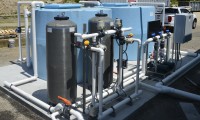
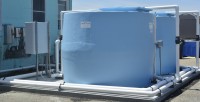
UMASS Amherst Gloucester Marine Station is located in Gloucester, Massachusetts. The Gloucester Marine Station is in the process of being revitalized by UMASS Amherst to perform an important role in the research of local species that find themselves in the flux of environmental changes. In order to conduct their research they required 2 things, a reliable and clean source of filtered sea water and a system of tanks where they could conduct controlled experiments that would withstand the harsh salt water environment. Oceans Design designed and installed a computer controlled sea water filtration system that would not only provide filtered sea water to the lab, but allowed for alarm notification in case water flow was lost, data log water quality parameters, record system events, and provide automated back washing of the filters. The system was a great success and research is ongoing at the marine station.
EARTH OCEAN FARMS
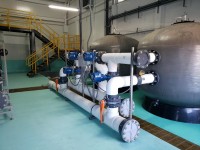
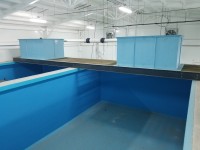
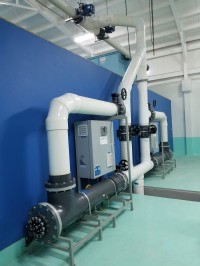
Earth Ocean Farms located in La Paz, Mexico cultures two different species commonly known as Red Snapper and Totoaba. In order to expand their operation they required a clean supply of filtered sea water at 1500 GPM to support their continued growth. Raw sea water was pumped from a welded HDPE suction box with copper mesh to inhibit growth on the screen. Two 10" HDPE suction lines we're installed with pigging ports to allow the periodic cleaning of the lines. Two 40HP centrifugal pumps outfitted with a vacuum priming system pulled water from a low tide elevation of 18 feet and pumped water to two FRP filtration vessels with a specialized media to filter water to 5 microns. Water is then passed through two UV Sterilizers and degassing towers before it is discharged into two 180m 33 epoxy coated concrete storage vessels. The filtration system is computer controlled to automatically backwash the filters, and utilizes level sensors in the storage tanks to speed up or slow down the pumps using variable frequency drives so the energy exerted to pump and filter water is equivalent to the demand wasting little water and energy.
BLUE OCEAN HAWAII


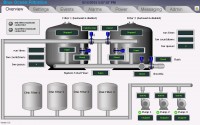
Blue Ocean Mariculture located in Kona, Hawaii presented an unusual challenge for Oceans Design. Where typically we are contracted to design a filtration system to clean the water of total suspended solids, in this case we were contracted to filter an invasive parasite that wreaked havoc on the facilities broodstock for years. As is typical with any parasite, the design must consider all life stages of the parasite, and its size at that stage. The parasite was too large to be effectively eradicated with traditional disinfection such as UV sterilization, and Ozone was deemed undesirable. After careful consideration a 3-stage filtration system was installed. Stage 1 utilized a battery of disc filters to pre-filter water to 60 microns before being pumped to two FRP filtration vessels with a specialized media to filter water to 5 microns. Given the importance of keeping this parasite out of the broodstock tanks a redundant system of high capacity cartridge filters with 5 micron cartridge filters was installed as the final stage of filtration. Our computer monitoring and control system was installed with the system to automate the back washes of the disc filters, media filters, and assure the design specific backwash flow rates we're always met by speeding up or slowing down down the pumps utilizing variable frequency drives associated with the pumps. Included with the automation package was the ability to receive alarm notifications, a data logging package to record temperatures, flow rates, and filters operation.
BAJA SEAS
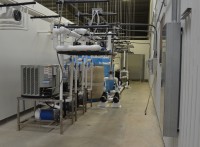
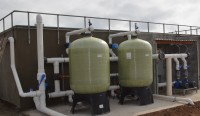
Baja Seas, located in Erendira, Mexico cultures the yellowtail, seriola lalandi. Having constructed their newly built hatchery and sea water intake, initial results we're poor with larval survival below 5%. Oceans Design was contracted to look at the the existing systems and determine what could be improved to get better survival through their larval stages. After completing our evaluation we recommended a system that had been proven in many other applications culturing yellowtail, a species we specialize in. Due to budget constraints we had to source equipment that we normally would not consider, but would not compromise the goals at hand. Oceans Design installed a media filtration system with a specialized media, a UV disinfection system to provide a high UV dosage across a wide range of flow rates, a natural gas temperature control system, and a polishing system to filter water to 1 micron. The subsequent larval run produced over a 100,000 larvae at a survival rate of 45%. Additional runs resulted in a survival rate of over 50% which is phenomenal for seriola Lalandi. The remarkable increase in survival was though a unique collaboration of professionals including the hatchery manager, larval consultant, and Oceans Design. The filtration system was one component and most in this industry know success is about addressing a 100 different details. With team work, we were able address the filtration, the live feeds quality, feeding, and temperature optimization which all together made the difference.
SAN DIEGO STATE COASTAL MARINE LABORATORY, SAN DIEGO CA
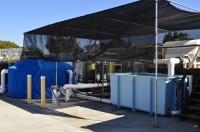
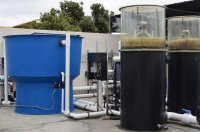
Oceans Design was commissioned to design and install a 200 gpm seawater intake system at it's new coastal marine laboratory supporting it's marine science graduate program. Sea water was to be pulled from a watershed connected to San Diego bay that had a unusually high level of silt particles in the 1-10 micron range in addition to particles typically found in sea water. Oceans Design inevitably installed a 2 tier filtration system, one for particles greater than 60 microns using a rotating drum filter, and the second, a polishing filtration system which included computer controlled media filters and intensive foam fractionation with ozone. The system was designed to easily clean the sea water lines of algae, mussels and other organisms growing in the pipes with one of our pigging systems. The project was a great success in providing the lab with high quality water for research and line maintenance is easily carried out 4-6 times a year.
|
|